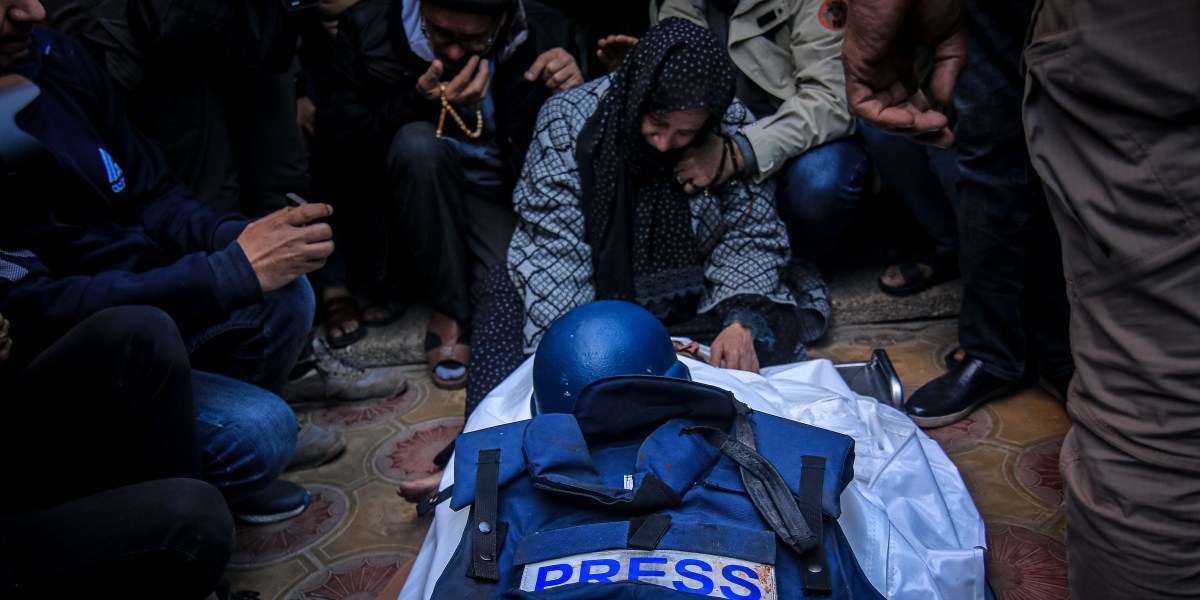- cross-posted to:
- news@beehaw.org
- cross-posted to:
- news@beehaw.org
“IT WAS AS if a storm had targeted us.” On the afternoon of December 15, an Israeli airstrike slammed into the Farhana school in Khan Younis where Al Jazeera Gaza bureau chief Wael al-Dahdouh and his cameraman, Samer Abu Daqqa, had just wrapped up filming the aftermath of an earlier bombardment in the area.
Dahdouh was thrown to the ground. “I lost balance to the point of faintly losing consciousness until I regained my strength,” he told The Intercept. “I tried to get up in any way because I was sure that another missile would target us — from our experience that’s what usually happens.” Dahdouh realized he was bleeding profusely from the arm and that if he didn’t get medical attention, he would die. He had also temporarily lost much of his hearing from the blast. He looked over and saw the three Civil Defense workers who had been accompanying the two journalists had been killed.
“In those milliseconds I thought I couldn’t offer him anything. I couldn’t. And he couldn’t move, he couldn’t get up.” Then, he saw Abu Daqqa lying on the ground some distance away. “He was trying to get up and it seemed like he was screaming,” Dahdouh said. “In those milliseconds I thought I couldn’t offer him anything. I couldn’t. And he couldn’t move, he couldn’t get up. I decided to take advantage of the remaining glimmer of hope, which was to try to go towards the ambulance.”
Dahdouh somehow managed to make his way across the rubble to an ambulance hundreds of meters away and was evacuated to a nearby hospital. But Abu Daqqa, wounded in the lower part of his body, could not walk to the ambulance and was left lying on the ground. Hours went by, but emergency workers were unable to reach him without approval from the Israeli military. As his life slipped away, Al Jazeera posted a live counter on its broadcast showing the number of hours and minutes since Abu Daqqa had been wounded. When emergency crews were finally able to reach Abu Daqqa over five hours later, he was dead.



This is the best summary I could come up with:
“It was as if a storm had targeted us.” On the afternoon of December 15, an Israeli airstrike slammed into the Farhana school in Khan Younis where Al Jazeera Gaza bureau chief Wael al-Dahdouh and his cameraman, Samer Abu Daqqa, had just wrapped up filming the aftermath of an earlier bombardment in the area.
Wearing helmets and flak jackets with the word “press” emblazoned on them, they made their way toward the school in an ambulance with a crew of uniformed Palestinian Civil Defense workers — a government branch responsible for emergency services and rescue — who had coordinated with and received approval from the Israeli military through the Red Cross to be in the area, according to Dahdouh.
At 5:27 p.m., a full three hours after Abu Daqqa was wounded in the airstrike, Krosney wrote that Israeli authorities had still not granted permission for emergency teams to reach him: “Ambulances still not cleared, but I am in touch with IDF, who know about this.
Halpern continued to urge journalists in the group to individually message Daniel Hagari or Richard Hecht — both Israeli military spokespeople whose contact information she had just shared — to pressure them to facilitate a rescue effort.
The FPA released a statement shortly afterward, saying it was “alarmed by the [Israeli] military’s silence and [called] for an immediate inquiry and explanation as to why it apparently attacked the area and why Samer could not be evacuated in time to be treated and potentially saved.”
The next day, Al Jazeera announced it was preparing a legal file to submit to the International Criminal Court, or the ICC, over what it called the “assassination” of Abu Daqqa by Israeli forces in Gaza.
The original article contains 2,505 words, the summary contains 285 words. Saved 89%. I’m a bot and I’m open source!